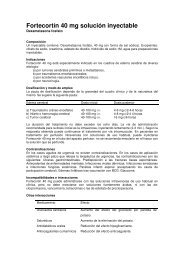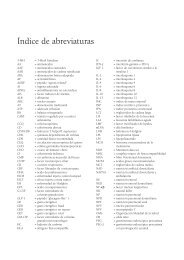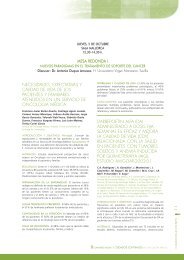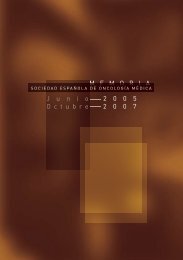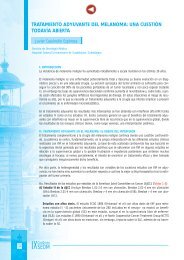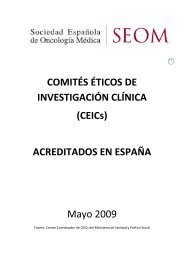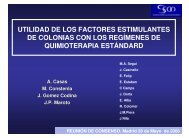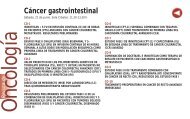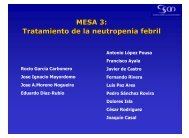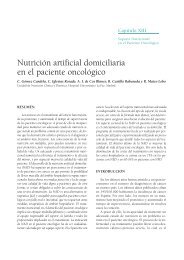Resúmenes de Ponencias - Sociedad Española de OncologÃa Médica
Resúmenes de Ponencias - Sociedad Española de OncologÃa Médica
Resúmenes de Ponencias - Sociedad Española de OncologÃa Médica
Create successful ePaper yourself
Turn your PDF publications into a flip-book with our unique Google optimized e-Paper software.
• COX-2: La <strong>de</strong>terminación por inmunohistoquímica <strong>de</strong> COX-2 en tejido tumoral ha mostrado que las<br />
pacientes con expresión <strong>de</strong> COX-2 tienen muy pobre respuesta a quimioterapia y una menor supervivencia<br />
(16) .<br />
• LRP: La expresión <strong>de</strong> LRP (Lung Resistance Protein), <strong>de</strong>terminada por inmunohistoquímica se asocia<br />
a una pobre respuesta a quimioterapia basada en platino y menor supervivencia (17) .<br />
• hTERT: la expresión <strong>de</strong>l gen humano <strong>de</strong> la transcriptasa inversa <strong>de</strong> telomerasa (hTERT), medida por RT-<br />
PCR, se ha <strong>de</strong>mostrado como un marcador in<strong>de</strong>pendiente <strong>de</strong> respuesta a quimioterapia basada en platino<br />
(18) .<br />
CONCLUSIONES<br />
El principal factor pronóstico en cáncer <strong>de</strong> ovario continúa siendo el estadio quirúrgico <strong>de</strong> la FIGO. En las<br />
pacientes con etapas iniciales el principal factor pronóstico es el grado, mientras que en las pacientes con<br />
enfermedad avanzada, el factor que más <strong>de</strong>termina la supervivencia es la dimensión <strong>de</strong> la enfermedad residual<br />
tras la primera cirugía citorreductora.<br />
Hasta este momento se han i<strong>de</strong>ntificado varios factores biológicos y moleculares que han <strong>de</strong>mostrado tener<br />
significado pronóstico o predictor <strong>de</strong> respuesta a esquemas basados en platino. Sin embargo, la ausencia <strong>de</strong><br />
gran<strong>de</strong>s estudios prospectivos que vali<strong>de</strong>n los resultados, y la dificultad <strong>de</strong> su <strong>de</strong>terminación en el contexto<br />
asistencial, hacen que no se hayan incorporado aún a la clínica diaria.<br />
BIBLIOGRAFÍA<br />
1. Jemal A, Thomas A, Murria T et al. Cancer statistics 2002. CA Cancer J Clin 2002; 52: 23-47.<br />
2. Ahmed FY, Wilshaw E, A´Hern RP et al. Natural history and prognosis of untreated stage I epithelial ovarian carcinoma.<br />
J Clin Oncol 1996; 14: 2968-2975.<br />
3. Vergote I, De Brabanter J, Fyles A et al. Prognostic importance of <strong>de</strong>gree of differentiation and cyst rupture in stage<br />
I invasive epithelial ovarian cancer. Lancet 2001; 357: 176-182.<br />
4. Tropé C, Kaern J, Hogberg T et al. Randomized study on adyuvant chemotherapy in stage I high-risk ovarian cancer<br />
with evaluation of DNA-ploidy as prognostic instrument. Ann Oncol 2000; 11: 282-288.<br />
5. Hoskins WJ, Bundy BN, Thigpen JT et al. The influence of cytoreductive surgery on recurrence-free interval and survival<br />
in small-volume stage III epithelial ovarian cancer: a Gynecologic Oncology Group study. Gyn Oncol 1992; 47:<br />
159-166.<br />
6. Hoskins WJ, McGuire WP, Brady MF et al. The effect of diameter of largest residual disease on survival after primary<br />
cytoreductive surgery in patients with suboptimal residual epithelial ovarian carcinoma. Am J Obst Gynecol 1994;<br />
170: 974-980.<br />
7. Allen DG, Heintz AP, Touw FW. A meta-analysis of residual disease and survival in stage III and IV carcinoma of the<br />
ovary. Eur J Gynaecol Oncol 1995; 16: 349-356.<br />
8. Bristow RE, Tomacruz RS, Armstrong DK et al. Survival effect of maximal cytoreductive surgery for advanced ovarian<br />
carcinoma during the platinum-era: a Meta-analysis. J Clin Oncol 2002; 20: 1248-1259.<br />
9. Junor EJ, Hole DJ, McNulty L et al. Specialist gynaecologist and survival outcome in ovarian cancer: A Scottish national<br />
study of 1866 patients. Br J Obstet Gynaecol 1999; 106: 1130-1136.<br />
10. Markman M, Lewis JL, Saigo P et al. Impact of age on survival of patients with ovarian cancer. Gynecol Oncol 1993;<br />
49:236-239.<br />
11. Omura GA, Brody MF, Homesley HD et al. Long-term follow-up and prognostic factor analysis in advanced ovarian<br />
carcinomas: the GOG experience. J Clin Oncol 1991: 9; 1138-1150.<br />
12. Costa MJ, Hansen CL, Walls JE et al. Immunohistochemical markers of cell cycle control applied to ovarian and primary<br />
peritoneal surface epithelial neoplasms: p21(WAF1/CIP1) predicts survival and good response to platinin-based<br />
chemotherapy. Hum Pathol 1999; 30:640-7.<br />
13. Baekelandt MM, Holm R, Nesland JM et al. P-glycoprotein expression is a marker for chemotherapy resistance and<br />
prognosis in advanced ovarian cancer. Anticancer Res 2000 ; 20:1061-7.<br />
14. Reles A, Wen WH, Schmi<strong>de</strong>r A et al. Correlation of p53 mutations with resistance to platinum-based chemotherapy<br />
and shortened survival in ovarian cancer. Clin Cancer Res 2001; 7: 2984-97.<br />
44<br />
Congreso<br />
IXSEOM



